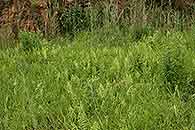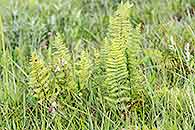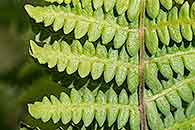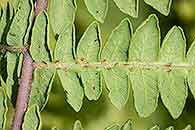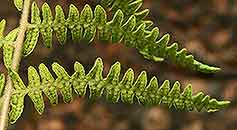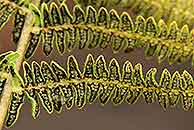Thelypteris confluens (Thunb.) C.V. Morton
Synonyms |
Nephrodium thelypteris sensu Sim |
|---|---|
Common name |
|
Description |
Rhizome long, creeping and branching, 2-3 mm in diameter; rhizome scales ovate in outline, margin somewhat wavy, up to 2 mm long, dark brown, nonpersistent. Fronds monomorphic, spaced 1-5 cm apart, erect or arching, up to c. 1m tall, not proliferous, herbaceous. Stipe up to 50 cm long, pale brown, often blackened towards the base, subglabrous. Lamina deeply 2-pinnatifid, up to 60 × 21 cm, lanceolate to elliptic in outline, apex tapering to a point with a pinnatifid terminal segment, lower pinnae slightly reduced and widely spaced; pinnae linear to oblong-lanceolate in outline, deeply pinnatifid into oblong and rounded to triangular and acute ultimate lobes, margins entire; under surface glabrous, glandular or thinly pilose and with pale brown ovate scales along the costa, upper surface hairless; veins forked or often simple, not meeting the veins of the adjacent lobes; rhachis pale brown, hairless. Sori up to 18 per lobe, round, situated halfway between the costa and the margin; indusia kidney-shaped, membranous, hairless or with short marginal hairs. |
Notes | Found together with Cyclosorus interruptus which has a zigzag soral pattern, one pair of veins meeting below and a pair of veins meeting at the sinus, leathery pinnae that are incised a third to halfway to the costa.
|
Derivation | confluens: converging, running together; may be a reference to the intertwined rhizomes that give rise to extented, densely clustered stands. |
Habitat | In full sun or light shade of marshy areas with perennial surface water. |
Distribution worldwide | Africa, Madagascar, southern India, Thailand, Sumatra, Papua New Guinea, Australia, New Zealand. |
Distribution in Africa |
Angola, Botswana, Burundi, Cameroon, Congo, Dem. Republic of Congo, Ethiopia, Kenya, Malawi, Mozambique, Namibia, Nigeria, Rwanda, South Africa, Sudan and South Sudan, Swaziland, Tanzania , Uganda, Zambia, Zimbabwe. |
Growth form |
Terrestrial. |
Literature |
|
